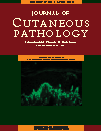CD4/CD8 double negative pagetoid reticulosis: a case report and literature review
Abstract
Pagetoid reticulosis is an indolent primary cutaneous T-cell lymphoma. It typically presents as a solitary and slowly growing patch or plaque on the extremity, histologically characterized by an acanthotic epidermis infiltrated with atypical lymphocytes. Here, we present histological, immunophenotypical and molecular findings of a 29-year-old Jamaican man with bilateral wrist plaques. Histology showed marked acanthosis, hyperkeratosis and an intraepidermal infiltration consisting of large atypical lymphocytes. Immunohistochemical stains showed CD3 and CD5 positive T cells with significant loss of CD7, double negative CD4 and CD8 and strong positive CD30. Molecular analysis showed a monoclonal T-cell receptor (TCR) gamma gene rearrangement. Review of the literature confirms that the immunophenotype of pagetoid reticulosis is variable with decreasing frequency of CD8+ cytotoxic/suppressor T cell, CD4+ helper T cell and least commonly CD4/CD8 double negative phenotypes. Although CD4/CD8 double negative phenotype appears to be associated with higher proliferation index, it does not appear to confer prognostic significance.
Mourtzinos N, Puri PK, Guanghua W, Liu M-L. CD4/CD8 double negative pagetoid reticulosis: a case report and literature review.




